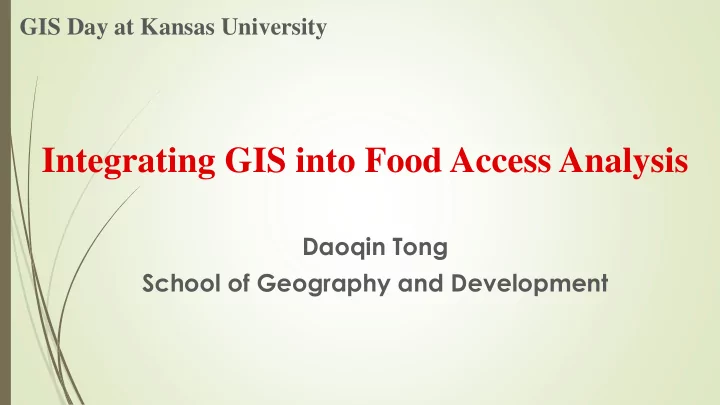

GIS Day at Kansas University Integrating GIS into Food Access Analysis Daoqin Tong School of Geography and Development
Outline Introduction Research questions Method Results Discussion
Introduction Food insecurity issues >14% U.S. households SNAP served 15% of the U.S. population from 2012-2014 Related health outcomes (Adams et al. 2003) Higher incidence of obesity Diabetes High blood pressure http://stateofobesity.org/food-insecurity/
“ Food Desert” UK Low Income Project Team areas of relative exclusion where people experience physical and economic barriers to accessing healthy food USDA “ urban neighborhoods and rural towns without ready access to fresh, healthy, and affordable food” Low access Supermarket availability Urban areas: 1 mile; rural area: 10 miles Low income/poverty
Food Desert in the U.S. Low-income and low access 37.6 million live in food deserts Data source http://www.ers.usda.gov/data-products/food- access-research-atlas/download-the-data.aspx
More about Food Desert Identification Analysis Scale Census tract Policy needs; consistent with multiple Federal agencies’ programs Healthy, affordable food outlet Follow the industry-standardized definition of a supermarket Focus on brand-name chain stores selling a full range of goods
Issues of Current Practices Census tract might be too coarse Do not necessarily reflect the neighborhood divisions Fail to provide sufficient knowledge about the geographic variation among neighborhoods How about other types of food retailers smaller grocery shops may fill the gap (Apparicio et al. 2007; Joassart- Marcelli et al. 2014)
Research Questions How does the scale definition affect the assessment of food deserts or food access in general? Is there a difference? If yes, how the difference varies across different neighborhoods? The role of independent stores Whether these food outlets help reduce food deserts To what extent these food outlets change food access In what geographical and social locations such changes take place.
Relevant Work Conflicting research findings about the relationships between food access and demographic and socioeconomic characteristics (Dutko et al. 2012) Regions of various sizes, cultural and historical background The two national level studies also gave contradicting results Powell et al. (2006)-Zip code level USDA (2009) -1-square-kilometer grids
Alternative Food Stores Independent stores (Apparicio et al. 2007; Joassart- Marcelli et al. 2014) Suggested the importance of small stores in filling the gap Farmers’ markets and community gardens (Wang et al 2014) Help improve food access and relieve food desert issue to some extent
Study Area Tucson, AZ 20.4% poverty rate 16% of the total population are found to be food insecure Diverse demographic profile Hispanic population Seasonal fluctuation of migrants College population
Data Collection Chain stores Official website and store locator 91 in total Independent stores ReferenceUSA, google search and groundtruthing 45 in total Census demographic and socioeconomic information Block group Census tract Street network
Analysis Methods Food Deserts Food access metrics (Apparicio et al. 2007; Larsen et al. 2008) Proximity based measure Travel distance to the closest food store Variety based measure nearest The number of food stores within a travel distance/time threshold Diversity based measure the average travel distance/time to a number of (k=3) different stores Using the analysis scale of block group and tract With and without independent stores GIS, Network based distance
Measure I - Proximity Distance to the nearest grocery store Immediate proximity Weighted aggregation based on blocks p d b b D 1 b Mt t p b b Mt 1 is the mean distance of census tract t from the nearest grocery store; 𝐸 𝑢 b is the index of blocks M t is the set that contains all the blocks in tract t 𝑞 𝑐 is the total population in block b 𝑒 𝑐 is the distance from the centroid of block b to the nearest store.
Measure II-Diversity p s b b b Mt N t p b b Mt N t is the mean number of grocery stores within a designated distance (i.e. 1 mile) of tract t; s b is the number of stores within a designated distance (i.e.1 mile) of block b
Measure III-Variety p d b bj b Mt j 1 ,.., n 2 D t n p b b Mt 2 is the mean distance between census tract t and stores 𝐸 𝑢 under n different brands; d is the distance between block b and the closest store of bj brand j; 𝑜 is the number of different brands (n=3 is used in this study)
Food Deserts 217 census tracts in total; 60 high poverty tracts Chain stores only: 31 census tracts (14.3%); 123,333 people (13.9%); 47% are Latino All stores: 17 census tracts (7.8%); 76,373 people (8.6%); 57% are Latino
Food Access – Measure I 1.86 miles vs. 1.66 miles
Food Access – Measure II
Food Access – Measure III 2.4 miles vs. 1.9 miles
Food Deserts Identified at Different Scales 125,367 people (14.1%) are found to live in food desert at the block group level compared to 76,373 (8.6%) identified at the census tract level
Variety based measure Proximity based measure Diversity based measure
Discussion Differences appear to exist in levels of food access Assessment metrics Scales Coarser scale (tract) leads to underestimate of food deserts Independent stores help improve food access Diversity and Variety Proximity
Discussion (Cont’d) Mode of transportation Car How about those who highly rely upon publication transportation Transportation routes Schedule GTFS data ArcGIS provides the “Transit Analysis Tools”
Conclusion GIS provides a critical role in food access and food desert assessment Caution should be given to the analysis scale used to perform food desert or food access assessment Sensitivity analysis A comprehensive assessment is needed for a policy intervention aimed at reducing food deserts
Recommend
More recommend